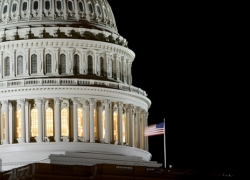Govern your data center more effectively with comprehensive monitoring
Govern your data center more effectively with comprehensive monitoring

One of the most frustrating aspects of data center management is the sheer number of variables that can affect the performance of the servers. Heat, humidity, power consumption, airflow, equipment failures and a variety of other factors must be accounted for to prevent downtime and offer the best possible services to customers.
In the case of federal governments, these customers are the people. Often the public services that suffer from data center downtime are essential state offerings such as access to tax forms, voter registration information, government-subsidized health care, applications for permits and travel documents, and other important web portals that help governments connect with the people they serve.
Given the high-stakes of downtime in a government data center, it's vital that facility managers not only know what to look out for in order to preempt downtime, but that they also find ways to operate their facilities as cost-efficiently as possible. Comprehensive data-center monitoring can help achieve this in the following ways:
Catch infrastructure problems early
There are countless threats to data center equipment. While data center infrastructure management (DCIM) may give operators the potential for a 360-degree view of their facilities, this panorama will only be complete if management has the technology in place to aggregate real-time data.
Enter data center monitoring.
"Instead of waiting for inevitable problems to occur, admins should actively collect data, analyze trends and be ready to react," wrote TechTarget's Jim O'Reilly. "[I]ntelligent use of IT monitoring software and trend analysis will make IT much more responsive to data center challenges and tamp down real crises."
Comprehensive monitoring that achieves all of the above requires certain infrastructure updates. For instance, power monitoring at the power distribution (PDU) level can help keep electrical loads balanced by notifying management when electricity usage threatens to exceed allowable thresholds. Strategically placed temperature monitors help prevent overheating. Humidity monitors will detect when a surplus of moisture in the air that may cause condensation. Conversely, a lack of enough moisture in the air can result in electrostatic discharge that damages equipment. Likewise, flood sensors that are designed to identify leaks or bigger flooding incidents can be placed in areas where water might pool. Dry-contact sensors near doors will alert operators to unauthorized entry (an essential feature in secure government data center facilities). Last but not least, feeds from well-placed, IP-based cameras can be viewed remotely and in real time. This provides authorized personnel with visual confirmation that all is well in the data center.

Optimize resource efficiency
It's no secret that in the United States, government agencies at the federal and state levels are doing everything they can to try to optimize IT infrastructure. For several years now, data center consolidation has been one of the key strategies to achieving this objective. While the government has already reaped savings by shuttering thousands of data centers, it can save more money yet by optimizing resource efficiency in those data centers that remain operational.
"Make the best use of available resources."
Data center monitoring helps in several key ways. Power monitoring in particular can help facility operators identify equipment that is being under-utilized. According to the Natural Resource Defense Council, as many as one-third of the servers in America were sitting "comatose" in data centers, idly consuming electricity, as of 2014. Shuttering facilities and consolidating functional servers can help eliminate this waste, but for government data centers to ensure ongoing maximization of electricity usage, they must rely on real-time power monitoring. In addition to pinpointing equipment that is being strained, power monitoring can identify comatose servers that are wasting energy and thereby inflating resource costs.
Likewise, temperature monitors can identify hotspots or sectors of a facility where computer room air conditioning (CRAC) units are working harder than is necessary. This is important considering that cooling accounts for roughly 40 percent of all the power consumed in data centers. Temperature and humidity monitoring can help data center managers curb excess energy expenditures by identifying the areas that need more or less cooling capacity.
At the end of the day, the resource consumption of data centers directly impacts the tax payers, since they're helping to keep the lights on in data centers. Using a comprehensive monitoring solution such as those produced by Geist will help to preempt the sources of downtime that cost the country money, and make the best use of available resources. The result is better national IT infrastructure, which translates to enhanced state services.



